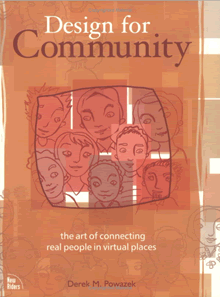September 6th
Open Letter to Derek Powazek
Dear Derek,
I’m writing to ask you if you would consider writing an update to your fantastic book Design for Community. Your book, as much as any other, helps to define what it means to create and curate community online. It’s a great book, but it’s a bit old and hard to find.
Web designers the world over, including myself, could really benefit from a 2nd edition. The world we’re designing for is all about community now, the social interactions of people in and around the things they’re passionate about. No longer are we a single person using a web site by ourselves. Now it’s all about multiple people participating, cooperating, and working together in countless ways. Community is a big part of that.
The copy of your book I had been using was at UIE, and since I’m not there everyday any more I don’t have easy access to it.
I tried to get myself a fresh copy of it the other day, and I couldn’t. On the publisher’s site (Peachpit Press) your book is simply not for sale. On Amazon it is unavailable new. Apparently, one of the best books on web design isn’t in print anymore!
Continue Reading: Open Letter to Derek Powazek

